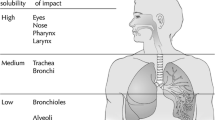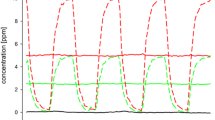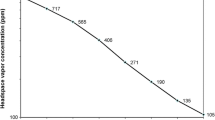Abstract
The sensory irritation effect of vapours of n-alkanes with 7–11 carbon atoms was determined from a trigeminal reflex, decreasing the respiratory rate in mice. The maximum effect within the first 10 min of the exposure period decreased from heptane to undecane, equivalent to a decrease in intrinsic activity. The concentration which depressed the respiratory rate by 50% (RD-50) was 17400 ppm for heptane. The n-alkanes C8–C11 were not able to produce this response level. The threshold concentration (RD-0) decreased from heptane to undecane, which corresponds to an increase in potency. The thermodynamic analysis suggests, however, that the affinity constants are equal, and thus the increase in potency is suggested to be due to altered distribution between the gas-air phase and the receptor phase. The expression 0.2 · RD-0 was used to estimate the upper limits for sensory irritation which are expected to be acceptable in the industrial working environment. The corresponding limits are 1205, 605 and 125 ppm, for heptane, octane and nonane, respectively. For decane the limit is expected to be above 22 ppm. We were not able to obtain an estimate for undecane due to the low intrinsic activity. Pulmonary irritation was found to be weak, except for heptane.
Similar content being viewed by others
References
Alarie Y (1973) Sensory irritation of airborne chemicals. CRC Crit Rev Toxicol 2: 299–363
Alarie Y (1981 a) Dose-response analysis in animal studies: prediction of human responses. Environ Health Perspect 42: 9–13
Alarie Y (1981 b) Toxicological evaluation of airborne chemical irritants. In: Leong BKJ (ed) Proceedings of the inhalation toxicology and technology symposium. Ann Arbor Science Publishers, Collongwood, pp 207–231
ASTM (1984) Standard test method for estimating sensory irritancy of airborne chemicals. American Society for Testing and Materials. Philadelphia, Designation: E981–984
Beidler LM (1965) Comparison of gustatory receptors, olfactory receptors, and free nerve endings. Cold Spring Harbor Symp Quant Biol 30: 191–200
Cain WS (1974) Contribution of the trigeminal nerve to perceived odor magnitude. Ann NY Acad Sci 237: 28–34
Cain WS (1976) Olfaction and the common chemical sence: some psychophysical contrasts. Sensory Processes 1: 57–67
Carpenter CP, Geary OL, Meyers RC, Nachreiner DJ, Sullivan LJ, King JM (1978) Petroleum hydrocarbon toxicity studies XVII. Animal response to n-nonane vapor. Toxicol Appl Pharmacol 44: 53–61
Coates M, Connell DW, Barron DM (1985) Aquous solubility and octan-l-ol to water partition coefficients of aliphatic hydrocarbons. Environ Sci Technol 19: 628–632
Colquhoun D (1971) Lectures on biostatistics. Clarendon Press, Oxford
Doty RL (1975) Intranasal trigeminal detection of chemical vapours by humans. Physiol Behav 14: 855–859
Engen T (1986) Perception of odor and irritation. Environ Int 12: 177–187
Ferguson J (1939) The use of chemical potentials as indices of toxicity. Proc R Soc Lond (Biol) 127: 387–404
Fühner H (1921) Die narkotische Wirkung des Benzins und seiner Bestandteile (Pentan, Hexan, Heptan, Octan). Biochem Z 115: 235–261
Gemert LJ van, Nettenbreijer AH (1977) Compilation of odour thresholds values in air and water. National Institute for Water Supply. Voorburg and Central Institute for Nutrition and Food Research TNO, Zeist
Hald A (1960) Statistical theory with engineering applications. John Wiley & Sons, New York
Keverne EB, Murphy CL, Silver WL, Wysocki CJ, Meredith M (1986) Non-olfactory chemoreceptors of the nose: recent advances in understanding the vomeronasal and trigeminal system. Chem Senses 11: 119–133
Kjærgaard S, Mølhave L, Pedersen OF (1987) Human reactions to indoor air pollution: n-decane. In: Seifert B, Esdorn H, Fischer M, Rüden H, Wegner J (eds) Indoor air'87, vol 1, Institute for Water, Soil and Air Hygiene, Berlin, pp 97–101
Kristiansen U, Hansen L, Nielsen GD, Holst E (1986) Sensory irritation and pulmonary irritation of cumene and n-propanol: mechanism of receptor activation and desensitization. Acta Pharmacol Toxicol 59: 60–72
Miller I, Freund JE (1977) Probability and statistics for engineers. Prentice-Hall, Englewood Cliffs
Nielsen GD, Alarie Y (1982) Sensory irritation, pulmonary irritation, and respiratory stimulation by airborne benzene and alkylbenzenes: prediction of safe industrial exposure levels and correlation with their thermodynamic properties. Toxicol Appl Pharmacol 65: 459–477
Nielsen GD, Olsen J, Bakbo JC, Holst E (1985a) Propyl ether. I. Interaction with the sensory irritant receptor. Acta Pharmacol Toxicol 56: 158–164
Nielsen GD, Olsen J, Bakbo JC, Holst E (1985b) Propyl ether. II. Pulmonary irritation and anaesthesia. Acta Pharmacol Toxicol 56: 165–175
Patty FA, Yant WP (1929) Odor intensity and symptoms produced by commercial propane, butane, pentane, hexane and heptane vapor. Report of Investigations no. 2979. US Bureau of Mines. Pittsburgh, pp 1–10
Ruth JH (1986) Odor thresholds and irritation levels of several chemical substances: a review. Am Ind Hyg Assoc J 47: A-142 - A-151
Sandmeyer EE (1981) Aliphatic hydrocarbons. In: Clayton GD, Clayton FE (eds) Patty's industrial hygiene and toxicology, vol. 2B. John Wiley & Sons, New York, pp 3175–3220
Stuper AJ, Brügger WE, Jurs PC (1979) Structure-activity studies of olfactory stimulants. In: Stuper AJ, Brügger WE, Jurs PE (eds) Computer assisted studies of chemical structure and biological function. John Wiley and Sons, New York, pp 170–214
Swann HE, Kwon BK, Hogan GK, Snellings WM (1974) Acute inhalation toxicology of volatile hydrocarbons. Am Ind Hyg Assoc J 35: 511–518
Weast RC, Astle MJ (1980) CRC handbook of chemistry and physics. CRC Press, Boca Raton
References
Alarie Y (1973) Sensory irritation of the upper airways by airborne chemicals. Toxicol Appl Pharmacol 24: 279–297
Barrow CS, Alarie Y, Warrick JC, Stock MF (1977) Comparison of the sensory irritation response in mice to chlorine and hydrogen chloride. Arch Environ Health 32: 68–76
Brink FG van den (1977) General theory of drug-receptor interactions. Drug-receptor interaction models. Calculation of drug parameters. In: Rossum JM van (Ed) Kinetics of drug action. Springer-Verlag, Berlin, pp 169–254
Brink F, Posternak JM (1948) Thermodynamic analysis of the relative effectiveness of narcotics. J Cell Comp Physiol 32: 211–233
Ferguson J (1939) The use of chemical potentials as indices of toxicity. Proc R Soc Lond (Biol) 127: 387–404
Kane LE, Alarie Y (1978) Evaluation of sensory irritation from acrolein-formaldehyde mixtures. Am Ind Hyg Assoc J 39: 270–274
Kristiansen U, Hansen L, Nielsen GD, Holst E (1986) Sensory irritation and pulmonary irritation of cumene and n-propanol: mechanisms of receptor activation and desensitization. Acta Pharmacol Toxicol 59: 60–72
Nielsen GD, Alarie Y (1982) Sensory irritation, pulmonary irritation, and respiratory stimulation by airborne benzene and alkylbenzenes: prediciton of safe industrial exposure levels and correlation with their thermodynamic properties. Toxicol Appl Pharmacol 65: 459–477
Nielsen GD, Bakbo JC (1985) Sensory irritating effects of allyl halides and a role for hydrogen bonding as a likely feature at the receptor site. Acta Pharmacol Toxicol 57: 106–116
Silver W, Mason JR, Adams MA, Smeraski CA (1986) Sasal trigeminal chemoreceptors: responses to n-aliphatic alkohols. Brain Res 376: 221–229
Author information
Authors and Affiliations
Rights and permissions
About this article
Cite this article
Kristiansen, U., Nielsen, G.D. Activation of the sensory irritant receptor by C7–C11 n-alkanes. Arch Toxicol 61, 419–425 (1988). https://doi.org/10.1007/BF00293686
Received:
Accepted:
Issue Date:
DOI: https://doi.org/10.1007/BF00293686




